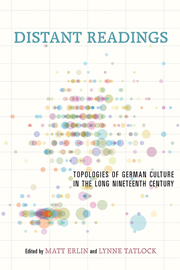Book contents
- Frontmatter
- Contents
- Acknowledgments
- Introduction: “Distant Reading” and the Historiography of Nineteenth-Century German Literature
- I Quantification
- 1 Burrows's Delta and Its Use in German Literary History
- 2 The Location of Literary History: Topic Modeling, Network Analysis, and the German Novel, 1731–1864
- 3 How to Read 22,198 Journal Articles: Studying the History of German Studies with Topic Models
- 4 Serial Individuality: Eighteenth-Century Case Study Collections and Nineteenth-Century Archival Fiction
- 5 The Case for Close Reading after the Descriptive Turn
- II Circulation
- III Contextualization
- Selected Bibliography
- Contributors
- Index
3 - How to Read 22,198 Journal Articles: Studying the History of German Studies with Topic Models
from I - Quantification
Published online by Cambridge University Press: 05 April 2014
- Frontmatter
- Contents
- Acknowledgments
- Introduction: “Distant Reading” and the Historiography of Nineteenth-Century German Literature
- I Quantification
- 1 Burrows's Delta and Its Use in German Literary History
- 2 The Location of Literary History: Topic Modeling, Network Analysis, and the German Novel, 1731–1864
- 3 How to Read 22,198 Journal Articles: Studying the History of German Studies with Topic Models
- 4 Serial Individuality: Eighteenth-Century Case Study Collections and Nineteenth-Century Archival Fiction
- 5 The Case for Close Reading after the Descriptive Turn
- II Circulation
- III Contextualization
- Selected Bibliography
- Contributors
- Index
Summary
In the past decade, research libraries have digitized their holdings, making a vast collection of scanned books, newspapers, and other texts conveniently accessible. While these collections present obvious opportunities for historical research, the task of exploring the contents of thousands of texts presents a challenge. This chapter introduces a family of methods, often called topic models, that can be used to explore very large collections of texts. Researchers using these methods may be found not only in computer science, statistics, and computational linguistics but also increasingly in the human and social sciences in fields such as women's history, political science, history of science, and classical studies. This introduction uses a topic model to explore a particular corpus, a collection of 22,198 journal articles and book reviews from four US-based German studies journals: The German Quarterly, New German Critique, German Studies Review, and Monatshefte. As this is the first time this corpus has been explored using quantitative methods, this introduction also presents a new perspective on the disciplinary history of German studies.
This chapter has three parts. First, I review existing methods that researchers, often historians, have used to explore very large collections of texts. Then I introduce a topic model—a probabilistic model of words appearing in a collection of texts—as an alternative way of reading a corpus. I aim to show that a topic model of the German studies journals reveals disciplinary trends that would be immensely time consuming to document otherwise. Finally, I discuss prospects for using topic models in nineteenth-century research generally and in intellectual history specifically.
- Type
- Chapter
- Information
- Distant ReadingsTopologies of German Culture in the Long Nineteenth Century, pp. 91 - 114Publisher: Boydell & BrewerPrint publication year: 2014

